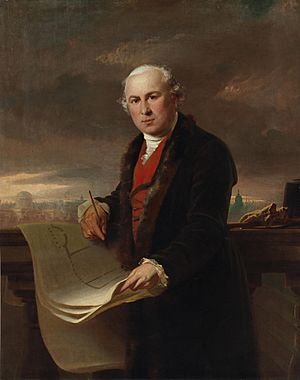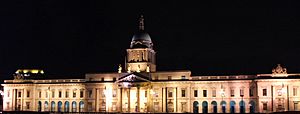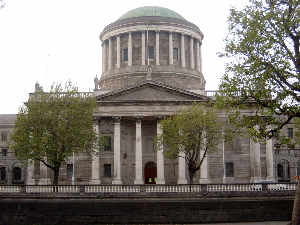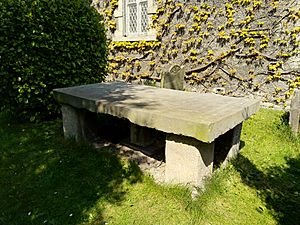James Gandon facts for kids
Quick facts for kids
James Gandon
|
|
|---|---|
 |
|
| Born | 20 February 1743 New Bond Street, London
|
| Died | 24 December 1823 (aged 80) Drumcondra, Dublin, Ireland
|
| Resting place | Drumcondra Church, Drumcondra, Dublin, Ireland |
| Occupation | Architect |
| Known for | Architect of Four Courts, The Custom House, King's Inns, Dublin, Ireland |
James Gandon (born February 20, 1743 – died December 24, 1823) was a talented English architect. He is most famous for the amazing buildings he designed in Ireland during the late 1700s and early 1800s. Some of his best-known works include The Custom House, the Four Courts, and the King's Inns in Dublin. He also designed Emo Court in County Laois.
Contents
Early Life of James Gandon
James Gandon was born in London on February 20, 1743. His grandfather was a French refugee. James was the only son of Peter Gandon, who was a gunmaker.
From 1749, James went to Shipley's Drawing Academy. Here, he learned about classic subjects, math, art, and architecture. After leaving the academy, he trained to be an architect with Sir William Chambers. Chambers taught him a grand, classical style of building called neoclassicism. This style used ideas from ancient Greek and Roman buildings.
In 1765, Gandon started his own architecture business. His first project was on Sir Samuel Hellier's estate. Around 1769, he entered a competition to design the new Royal Exchange in Dublin. He came in second place, but this made important people notice his skills. These people were planning to rebuild much of Dublin, which was one of Europe's largest cities at the time.
Later, Gandon designed the County Hall in Nottingham, England. He also helped create two books called Vitruvius Britannicus. These books showed plans and drawings of grand, classical buildings by famous architects. In 1768, he won a gold medal for architecture from the Royal Academy in London.
Designing Dublin's Custom House

In 1780, Gandon was asked to work in Russia, but he said no. However, in 1781, when he was 38, he accepted an invitation to Ireland. John Beresford, a government official, asked him to oversee the building of the new Custom House in Dublin. The first architect for the project had died, so Gandon took over completely.
The new Custom House was not popular with everyone in Dublin. Some people complained it would change the city's layout and was being built on swampy land. It cost a huge amount of money, about £200,000. Some stories say that people were so against the Custom House and its taxes that Beresford had to hide Gandon in his home for the first three months.
This big project changed Gandon's career. Dublin became his home, and he spent the rest of his life designing buildings there. He lived near John Beresford, who was a key person in developing the city. Dublin was growing fast and becoming the fifth-largest city in Europe.
A group called the Wide Streets Commission hired Gandon to design new, grand homes around Mountjoy Square and Gardiner Street. These classical-style buildings became the homes of important people who worked in the new Irish Houses of Parliament. Gandon also designed Carlisle Bridge (now O'Connell Bridge) over the River Liffey. This bridge connected the north and south parts of the city.
Other Important Irish Buildings
Gandon designed many other buildings in Dublin, including:
- The Four Courts in 1786.
- The main part of King's Inns on Henrietta Street, started in 1795 and finished in 1816 by his student, Henry Aaron Baker.
- Improvements to the Rotunda Assembly rooms in 1786.
One of Gandon's less known buildings in Dublin is the Royal Military Infirmary from 1787. He also designed the fronts of shops on D'Olier Street and Burgh Quay. In 1785, he got a very important job: to add to the huge Irish Houses of Parliament. He built the famous curved wall that connects his new entrance for the House of Lords to the original building. This building is now the Bank of Ireland.
Gandon's work in Ireland was not only in Dublin. He also designed buildings outside the city. In 1784, he designed a new courthouse and jail in Waterford. He also worked on many private homes, such as Abbeville, Dublin for John Beresford in 1792. He designed Emo Court in County Laois between 1790 and 1796 for the Earl of Portarlington. He also designed Coolbanagher Church near Emo village.
His city planning work included creating a new area around the Custom House with curved rows of townhouses at Beresford Place in Dublin. He also designed parts of a new town called New Geneva in County Waterford, but it was never finished.
Challenges and Legacy
Even though Gandon's buildings were successful, he was not always popular. Many people disliked the taxes linked to the Custom House, and this made them dislike him too. Some even said he designed buildings just to make himself feel important. During the building of the Four Courts in the 1780s, a newspaper printed daily letters insulting Gandon and his designs.
In 1798, a period of unrest began in Ireland. Gandon, who was not popular, quickly went to London. When he came back to Dublin, the city had changed a lot. The Irish Houses of Parliament, which had led to so much building, were closed. Ireland was now ruled directly from London. Many rich families left their grand new homes in the city. As a result, Dublin became less important as a major European city.
James Gandon married Eleanor Smullen in 1770. They had five children. Gandon died on December 24, 1823, at his home in Lucan, County Dublin. He had lived in Dublin for 42 years. He was buried in the churchyard of Drumcondra Church, in the same grave as his friend Francis Grose. His tombstone shows that people respected him. It says his neighbors and friends walked 16 miles to his funeral.
After his death, many of Gandon's buildings were damaged or destroyed due to Ireland's history. The Custom House was burned in 1921 during the Irish War of Independence. Parts of it were rebuilt with a darker stone. The Four Courts was attacked in 1922 during the Irish Civil War and partly destroyed by a large explosion. Even though it was rebuilt, much of Gandon's original work inside is gone. We can only see his original designs from his drawings. The sides of the Four Courts were also made shorter to make the road wider. Despite these changes, Gandon's work is still very visible in Dublin today.




